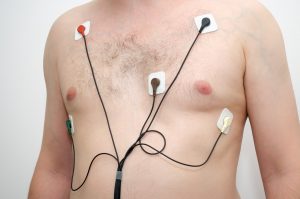 Tachycardia is an abnormally fast resting heart rate. A normal resting heart rate is between 60 and 100 beats per minute, which means anything over 100 is considered tachycardia. Heart rate threshold is often determined by a person’s age. The older we get, the less the heart pumps depending on what the body can handle. Hence, a rapid heart rate can be dangerous for senior patients as it adds stress to the heart and the body.
Tachycardia is an abnormally fast resting heart rate. A normal resting heart rate is between 60 and 100 beats per minute, which means anything over 100 is considered tachycardia. Heart rate threshold is often determined by a person’s age. The older we get, the less the heart pumps depending on what the body can handle. Hence, a rapid heart rate can be dangerous for senior patients as it adds stress to the heart and the body.
Even though the heart is beating faster, it isn’t pumping as efficiently, so the blood flow to the rest of the body is actually limited. A higher heart rate signifies a higher demand for oxygen by the heart muscle and in the long run can lead to a myocardial infarction (heart attack).
Advertisement
There are no immediate complications from tachycardia, but over time it increases one’s risk for stroke, sudden cardiac arrest, and death.
Types of tachycardia
There are different types of tachycardia:
Atrial fibrillation: Rapid heart rate caused by chaotic electrical impulses in the upper chambers of the heart (atria). The most common type of tachycardia, atrial fibrillation may be temporary or chronic. This condition can be well managed with medications.
Atrial flutter: Heart rate is rapid but steady as a result of weak contractions of the atria. Atrial flutter may resolve itself or treatment may be necessary.
Supraventricular tachycardia: Abnormally fast heartbeat that originates above the ventricles. It is caused by an abnormal circuitry present at birth.
Ventricular tachycardia: Abnormal heart rate that originates in the ventricles (lower chambers of the heart). Due to electrical signal abnormality, the ventricles cannot efficiently contract to pump sufficient blood supply to the body. Episodes may be brief, but if last for longer than a few seconds, the condition can be life threatening.
Ventricular fibrillation: Rapid, chaotic electrical impulses cause the ventricles to quiver ineffectively instead of pumping necessary blood to the body. If heart rhythm is not restored, this can be a life-threatening condition. Many patients with ventricular fibrillation have an underlying heart condition.
Tachy-brady syndrome: In tachycardia-bradycardia syndrome, the heart alternates between slow and fast rhythms. Tachy-brady is often seen in patients diagnosed with atrial fibrillation.
Causes and complications of tachycardia
 Tachycardia is brought on by disruption of the heart’s electrical circuitry. There are various causes contributing to the onset of tachycardia, including damage to the heart tissues due to heart disease, abnormal electrical pathways in the heart present at birth, inborn defect of the heart, anemia, exercise, sudden stress, high or low blood pressure, smoking, fever, excessive alcohol consumption, caffeine overuse, side effect of medications, abuse of recreational drugs, imbalance of electrolytes, or an overactive thyroid.
Tachycardia is brought on by disruption of the heart’s electrical circuitry. There are various causes contributing to the onset of tachycardia, including damage to the heart tissues due to heart disease, abnormal electrical pathways in the heart present at birth, inborn defect of the heart, anemia, exercise, sudden stress, high or low blood pressure, smoking, fever, excessive alcohol consumption, caffeine overuse, side effect of medications, abuse of recreational drugs, imbalance of electrolytes, or an overactive thyroid.
In some cases, tachycardia may be idiopathic, meaning the cause cannot be determined.
If left untreated, tachycardia can lead to complications such as the development of blood clots (increasing the risk of stroke or heart attack), the heart’s inability to pump adequate blood (heart failure), frequent fainting spells or unconsciousness, and sudden death.
Tachycardia symptoms and risk factors
The initial symptom of tachycardia is a rapid heart rate. Other symptoms are usually associated with insufficient supply of oxygenated blood to other areas of the body. Symptoms include shortness of breath, lightheadedness, rapid pulse, heart palpitations, chest pain, and fainting.
Some patients may not experience any symptoms, so tachycardia may not be detected until a routine physical examination.
Risk factors for tachycardia include heart disease, high blood pressure, sleep apnea, overactive and underactive thyroid, smoking, diabetes, heavy alcohol use, heavy caffeine use, use of recreational drugs, psychological stress or anxiety, anemia, old age, and family history of tachycardia.
Tests to diagnose tachycardia
 Tachycardia is usually diagnosed based on the review of the patient’s medical history, physical examination, and other supporting tests. For best treatment, it’s important to identify the specific type of tachycardia present.
Tachycardia is usually diagnosed based on the review of the patient’s medical history, physical examination, and other supporting tests. For best treatment, it’s important to identify the specific type of tachycardia present.
The first test is known as electrocardiogram, which records the heart’s electrical activity. To complete this test, patches are placed along the chest and the information is recorded. An ECG can be completed in a doctor’s office. Alternatively, you can wear either a Holter device (portable ECG device) or an event monitor (a wearable, portable device recording your heart activity over the course of few weeks).
Advertisement
The patient may also undergo an electrophysiological test, which can help detect where in the heart tachycardia is originating from. A catheter with electrodes is inserted and guided to specific areas of the heart in order to map the electrical pulses.
Imaging tests can be useful, too, to detect any structural problems with the heart. These include echocardiogram, MRI, CT scan, coronary angiogram, and a chest X-ray.
Other tests include a stress test performed on a treadmill measuring the reaction of the heart to physical stress and a tilt table test where the patient is placed on a table that tilts to mimic standing up to observe how the heart reacts to change in position. Your doctor may also run blood work and some other tests to determine the underlying cause of tachycardia.
